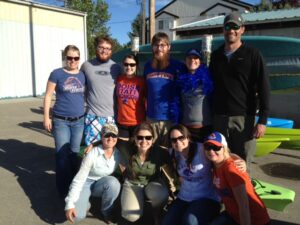Professor, Department of Biological Sciences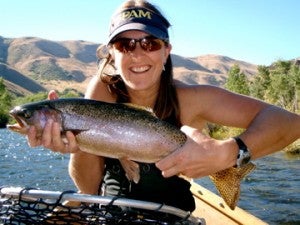
Department: Biological Sciences
Year arrived at BSU: 2008
Contact Information
Mailing Address:
Department of Biological Sciences
Boise State University
Boise, ID 83725-1515
Office Location: Science 102C
Office Number: 208-426-4426
Office Fax: 208-426-1040
E-Mail Address: jenniferforbey@boisestate.edu
Curriculum Vitae
ACADEMIC DEGREES
- B.S., Mesa State College, 1997
- Ph.D., University of Utah, Biology, 2003
- National Science Foundation International Research Postdoctoral Fellow (Australia & New Zealand), 2003-2007
TEACHING
- Zoology 409: Comparative Animal Physiology and Nutrition – View the ZOOL 409 Syllabus
- EEB 604: Convergence and Communication in Science (Currently Science and Communication II) – View the EEB 604 Syllabus
Teaching Philosophy
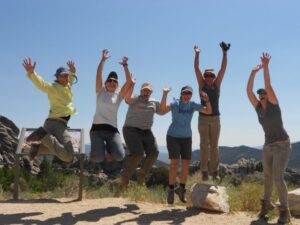
My goal as an educator and mentor is to provide the knowledge to transform students into independent and analytical thinkers and broadly prepare students for careers in science. I provide skills in analytical thinking by offering opportunities to write critically, communicate and debate scientific issues with their peers and design, conduct and analyze scientific research. Moreover, my experiences conducting research in academic, industrial and governmental settings will allow me to mentor students interested in careers in a variety of scientific disciplines. I believe that my teaching background, commitment to students and experience in diverse scientific career paths will contribute to the outstanding education, research opportunities and mentoring students expect from Boise State.
RESEARCH INTERESTS
Animals are faced with the daily challenge of processing large quantities of toxins present in their environment. However, the way animals respond and deal with these toxins is poorly understood. I am interested in understanding the behavioral and physiological consequences of exposure to plant secondary metabolites (i.e. toxins) and the mechanisms that herbivores employ to mitigate the negative effects of exposure to plant toxins. My research focuses on two general areas related to plant-herbivore interactions employing a combination of laboratory and field-based approaches:
Genomics Underlying Toxin Tolerance (GUTT)
I currently work with a team from Idaho, Nevada, and Wyoming who secured a $6 million award from the National Science Foundation (NSF) to predict and manage the interactions between toxic plants and the animals that consume these plants. The project, titled “Genomes Underlying Toxin Tolerance” is known as GUTT.
The vision of our GUTT project is to create a community of experts who can predict and manage toxin tolerance.
The shared mission of our GUTT community is to identify the molecular innovations that predict phenotypes of toxin tolerance in wild vertebrate herbivores through practices that strengthen inclusive research and education.
To achieve our vision and mission, our GUTT team integrates three research goals with a workforce development goal to increase scientific capacity to monitor, quantify and predict toxin tolerance in vertebrate herbivores consuming natural plants. Our research will have a translational impact on understanding and managing how wild and domestic animals, humans, and the microbial communities within the guts of all organisms interact, tolerate, and respond to exposure to any ingested chemical. Our research is important for:
- conservation biologists that manage native plants and herbivores
- the ranching and agricultural community that rely on plants to feed livestock and rely on chemicals to defend crops from pests
- the medical community that relies on plant-derived chemicals to manage human health.

Goal 1: Monitor
Monitor molecular mechanisms of toxin tolerance. To meet this goal, we converge the disciplines of chemistry, genomics, bioinformatics, and modeling to monitor the molecular mechanisms by which herbivore and gut microbial genomes interact with phytochemicals.
Goal 2: Quantify
Quantify physiological mechanisms of toxin tolerance. To meet this goal, we use in vivo data and in vitro bioassays to quantify rates of toxin absorption and metabolism and toxin-dependent changes in digestive function in the host and in the gut microbiome.
Goal 3: Predict
Predict demographic consequences of toxin exposure. To meet this goal, we use molecular mechanisms from Research Goal #1 and physiological mechanisms from Research Goal #2 coupled with in vivo manipulation of wild animals to develop, validate, and iteratively refine models that predict how toxin exposure influences demography in herbivores.
Our major workforce development goal is to provide early-career faculty, postdoctoral fellows and graduate students innovative workforce development programs that increase their capacity to 1) recruit and retain a diverse workforce and 2) build diverse workplace networks. To meet this goal, we integrate research and education through course-based undergraduate research experiences (CUREs) and expand professional networks for all participants.
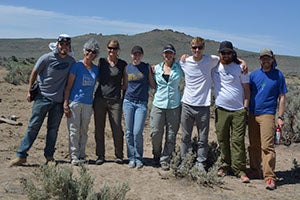 Pharm-Ecology
Pharm-Ecology
An ecological approach to natural product drug discovery: The main aim of this research is to utilize the technology and insight of two disparate, yet highly complementary fields: ecology (both physiological and chemical) and pharmacology (science of drugs, including their composition, uses, and effects) to discover the biological activity of natural products in the areas of infectious disease and cancer. Insight from the interactions between PSMs and the physiological and behavioral responses of herbivores to these compounds will expedite drug discovery and reveal the mechanisms by which bioactive molecules are therapeutic or toxic. For example, we have worked with high school students to identify the bioactive properties of sagebrush (http://news.boisestate.edu/update/2011/05/17/campus-read-book-inspires-winning-research-collaboration/). This research is supported by the National Institutes of Health (INBRE), the National Science Foundation, Fulbright and is a collaboration with the College of Idaho, Hedmark University of Applied Sciences, Icelandic Institute of Natural History and Grimsö Wildlife Research Station at Swedish University of Agricultural Sciences.
RECENT PUBLICATIONS
(previously Sorensen, J.S. Sorensen/Forbey authorship in bold, graduate student authorship indicated with *, undergraduate authorship indicated with **)
71. Hoy, S.R; JS Forbey, DP Melody, LM Vucetich, RO Peterson, KB Koitzsch, LO Koitzsch, AL Von Duyke, JJ Henderson, GL Parikh, JA Vucetich. 2022. The nutritional condition of moose co-varies with climate, but not with density, predation risk or diet composition. Oikos. DOI:10.1111/oik.08498
70. Staudenmaier AR*, LA Shipley, MJ Camp, JS Forbey, AE Hagerman, AE Brandt, DH Thornton. 2022. Mule deer do more with less: comparing their nutritional requirements and tolerances with white-tailed deer. Journal of Mammalogy. 103(1):178-195. DOI:10.1093/jmammal/gyab116
69. Robb, BC*, P.J. Olsoy, JJ Mitchell, TT Caughlin, DM Delparte, SJ Galla, MR Fremgen- Tarantino*, JD Nobler*, JL Rachlow, LA Shipley, JS Forbey. 2021. Near-infrared spectroscopy aids ecological restoration by classifying variation of taxonomy and phenology of a native shrub. Restoration Ecology e13584. DIO:10.1111/rec.13584.
68. Rosentreter R, BC Robb, JS Forbey. 2021. Using an ultraviolet light test to improve sagebrush identification and predict forage quality for wildlife. Western North American Naturalist. 81(2), 191-200. DOI:10.3398/064.081.0204
67. Hudon, S*; A Zaiats*, A Roser *, A Roopsind, C Barber *, BC Robb*, B Pendleton *, MJ Camp *, P Clark, M Davidson, J Frankel-Bricker, M Fremgen, JF Forbey, E Hayden, L Richards, O Rodriguez *, T Caughlin. 2021. Unifying community detection across scales from genomes to landscapes. Oikos. 130(6): 831-843. DOI: 10.1111/oik.08393 .
66. Guo H, JS Forbey, L Rongsong. 2021. Front propagation and blocking of reaction-diffusion systems in cylinders. Nonlinearity. 34(10): 6750-6772. DOI:10.1088/1361-6544/abd529
65. Fremgen-Tarantino, M*, PJ Olsoy, GG Frye*, JW Connelly, AH Krakauer, GL Patricelli, JS Forbey. 2021. Assessing accuracy of GAP and LANDFIRE land cover datasets in winter habitats used by greater sage-grouse in Idaho and Wyoming, USA. Journal of Environmental Management. 280: 111720. https://doi.org/10.1016/j.jenvman.2020.111720.
64. Hudon, S*; PH Esteban; J Beck *, S Burden, D Bendixsen *, K Callery * JS Forbey, L Waits, Lisette, R Miller *, O Nielsen, J Heath, E Hayden. 2021. Primers to highly conserved elements optimized for qPCR-based telomere length measurements in vertebrates. Molecular Ecology Resources. 21(1):59-67. doi: 10.1111/1755-0998.13238.
63. Newman, J*, M Maurer*, JS Forbey, R Brittas, Ö Johansson, ÓK Nielsen, T Willebrand, KD Kohl. Low activities of digestive enzymes in the guts of herbivorous grouse (Aves: Tetraoninae). Journal of Ornithology. https://doi.org/10.1007/s10336-020-01835-z.
62. Patey, D*, JS Forbey, S Kern, R Liu. 2020. Multiple Dose Pharmacokinetic Models Predict Bioavailability of Toxins in Vertebrate Herbivores. J Chem Ecol 46, 198–205. DOI: 10.1007/s10886-020-01146-w
61. Olsoy, P.J.*, JS Forbey, LA Shipley, JL Rachlow, BC Robb*, JD Nobler*, DH Thornton. 2020. Mapping foodscapes and sagebrush morphotypes with unmanned aerial systems for multiple herbivores. Landscape Ecology, 35(4):921-936. doi: 10.1007/s10980-020- 00990-1.
60. Fremgen, MR*; JJ Peña**; JW Connelly; JS Forbey. 2020. Availability and dietary quality of three-tip and Wyoming big sagebrush influence winter foraging ecology of Greater Sage- Grouse in a post-fire habitat. Journal of Arid Environments. 178, 104154. https://doi.org/10.1016/j.jaridenv.2020.104154
59. Dwinnell, S.*; Sawyer, H.; Randall, J.; Beck, J.; Forbey, J.S.; Fralick, G.; Monteith, K. 2019. Where to Forage When Afraid: Does Perceived Risk Impair Use of the Foodscape? Ecological Applications. https://doi.org/10.1002/eap.1972
58. Speed, J.D.M., I.Å. Skjelbred, I.C. Barrio, M.D. Martin, D.Berteaux, K. Christie, D. Ehrich, J.S. Forbey, D. Fortin7, J.Grytnes, K. Hoset, N. Lecomte, B. Marteinsdóttir, J. B. Mosbacher, Å. Pedersen, V. Ravolainen, E. Rees, S. Rozenfield, N. Sokolova, A. Thornhill, I. Tombre, E.M. Soininen. 2019. Trophic interactions and abiotic factors drive functional and phylogenetic structure of vertebrate herbivore communities across the Arctic tundra biome. Ecography. DOI:10.1111/ecog.04347.
57. Oh, K.P, C.L. Aldridge, J.S. Forbey, C.Y. Dadabay, S.J. Oyler-McCance, Conservation genomics in the sagebrush sea: population divergence, demographic history, and local adaptation in sage-grouse (Centrocercus spp.), Genome Biology and Evolution, evz112, https://doi.org/10.1093/gbe/evz112.
56. Forbey, J.S., R. Liu, T.T. Caughlin, M.D. Matocq, J.A. Vucetich, K.D. Kohl, M.D. Dearing, A.M. Felton. 2018. Review: Using physiologically based models to predict population responses to phytochemicals by wild vertebrate herbivores. Animal. 12(s2): s383-s398. doi: 10.1017/S1751731118002264. PMID: 30251623.
55. Nobler, JD*, MJ Camp*, MM Crowell*, LA Shipley, C Dadabay, JL Rachlow, L James**, JS Forbey. 2018. Preferences of specialist and generalist mammalian herbivores for mixtures versus individual plant secondary metabolites. Journal of Chemical Ecology. Published online: 06 Nov 2018. DOI: 10.1007/s10886-018-1030-5.
54. Pauli, B.P. E.R. Sun**, Z.K. Tinkle*, J.S. Forbey, K.E. Demps and J.A. Heath. Human habitat selection: Using tools from wildlife ecology to predict recreation in natural landscapes. Accepted Natural Areas Journal on 10/19/18.
53. Kohl, K.D. K.F. Oakeson, T.J. Orr, A.W. Miller, J.S. Forbey, C.D. Phillips, C. Dale, R.B. Weiss, M.D. Dearing. 2018. Metagenomic sequencing provides insights into microbial detoxification in the guts of small mammalian herbivores (Neotoma spp.). FEMS Microbiology Ecology. 94 (12). doi: 10.1093/femsec/fiy184.
52. Smith, Kurt*, J.S. Forbey, J.L. Beck. 2018. Effects of mowing and tebuthiuron treatments on the nutritional quality of Wyoming big sagebrush. Rangeland Ecology & Management: 71:47-423.
51. Crowell, M. M*., L. A. Shipley, J. S. Forbey, J. L. Rachlow, and R. G. Kelsey. 2018. Dietary partitioning of toxic leaves and fibrous stems differs between sympatric specialist and generalist mammalian herbivores. Journal of Mammalogy 99:565-577, https://doi.org/10.1093/jmammal/gyy018.
50. Milling, C.R.*, J.L. Rachlow, P.J. Olsoy*, M.A. Chappell, T.R. Johnson, J.S. Forbey, L.A. Shipley, and D.H. Thornton. 2018. Habitat structure modifies microclimate: an approach for mapping fine-scale thermal heterogeneity. Methods in Ecology and Evolution 9:1648-1657.DOI: 10.1111/2041-210X.13008.
49. Milling*, C. R., J. L. Rachlow, M. A. Chappell, M. J. Camp*, T. R. Johnson, D. R. Paul, L. A. Shipley, and J. S. Forbey. 2018. Seasonal temperature acclimatization in a semi-fossorial mammal and the role of burrows as thermal refuges. PeerJ 6:e4511; DOI 10.7717/peerj.4511.
48. Camp*, M. J., L. A. Shipley, C. R. Milling*, J. L. Rachlow, and J. S. Forbey. 2018. Interacting effects of ambient temperature and food quality on the foraging ecology of small mammalian herbivores. Journal of thermal biology, 71, 83-90.
47. McMahon, L. A.*, J. L. Rachlow, L. A. Shipley, J. S. Forbey, and T. R. Johnson. 2017. Habitat selection differs across hierarchical behaviors: Selection of patches and intensity of patch use. Ecosphere 8(11):0.1993.
46. Olsoy, P, J.*, L. A. Shipley, J. L. Rachlow, J. S. Forbey, N. Glenn, M. Burgess, and D. Thornton. 2017. Unmanned aerial systems measure structural habitat features for wildlife across multiple scales. Methods in Ecology and Evolution. 9(3): 594-604. DOI:10.1111/2041-210X.12919.
45. Camp*, M. J., L. A. Shipley, T. R. Johnson, P. Olsoy*, J. S. Forbey, J. L. Rachlow, and D. Thornton. 2017. The balancing act of foraging: Mammalian herbivores trade-off multiple risks when selecting food patches. Oecologia 185:537-549, DOI 10.1007/500442-017-3957-6 .
44. Milling*, C.R., J.L. Rachlow, T.R. Johnson, J.S. Forbey, and L.A. Shipley. 2017. Seasonal variation in behavioral thermoregulation and predator avoidance in a small mammal. Behavioral Ecology 28: 1236-1247. doi:10.1093/beheco/arx084.
43. McMahon, LS*, JL Rachlow, LA Shipley, JS Forbey, TR Johnson, PJ Olsoy*. 2017. Evaluation of micro-GPS receivers for tracking small-bodied mammals. PLoS ONE 12(3): e0173185. doi.org/10.1371/journal.pone.0173185.
42. Parikh, G. L.*, Forbey, J. S., Robb, B.**, Peterson, R. O., Vucetich, L. M. and Vucetich, J. A. 2017. The influence of plant defensive chemicals, diet composition, and winter severity on the nutritional condition of a free-ranging, generalist herbivore. Oikos, 126:196-203. doi:10.1111/oik.03359.
41. Forbey, JS, GL Patricellii, DM Delparte, AH Krakauer, PJ Olsoy*, MR Fremgen*, JD Nobler*, LP Spaete, LA Shipley, JL Rachlow, AK Dirksen*, APerry*, BA Richardson, NF Glenn. 2017. Emerging Technology to Measure Habitat Quality and Behavior of Grouse: examples from studies of Greater Sage-grouse. Wildlife Biology, 2017(SP1) DIO:10.2981/wlb.00238.
40. Fremgen, MF*, D Gibson, RL Ehrlich*, AH Krakauer, JS Forbey, EJ Blomberg, JS Sedinger, GL Patricelli. 2017. Necklace-style radio-transmitters are associated with changes in display vocalizations of male Greater Sage-grouse. Wildlife Biology, 2017(SP1). DOI: 10.2981/wlb.00236.
39. Sherburne, Jessica*; Anaya, Amanda; Fernie, Kim; Forbey, Jennifer; Furlong, Edward; Kolpin, Dana; Dufty, Alfred; Kinney, Chad. The occurrence of triclocarban and triclosan within a terrestrial food web: from biosolids to birds. Environmental Science & Technology 50.24 (2016): 13206-13214.
38. Olsoy PJ*, Griggs TC, Ulappa AC*, Gehlken K**, Shipley LA, Shewmaker GE, Forbey JS. 2016. Nutritional analysis of sagebrush by near-infrared reflectance spectroscopy. Journal of Arid Environments 134:125-131. doi:10.1016/j.jaridenv.2016.07.003.
37. Kohl, K.D., J.W. Connelly, M.D. Dearing, J.S. Forbey. 2016. Microbial detoxification in the gut of a specialist avian herbivore, the Greater Sage-Grouse. FEMS microbiology letters. fnw144.
36. Crowell, MM*, LA Shipley, MJ Camp*, JL Rachlow, JS Forbey, and TR Johnson. 2016. Selection of food patches by sympatric herbivores in response to concealment and distance from a refuge. Ecology and Evolution, 6(9), 2865-2876. doi:10.1002/ece3.1940.
35. Utz, J.*, L.A. Shipley, J. Rachlow, T.L. Johnstone-Yellin, M.J. Camp*, J.S. Forbey. 2016. Understanding tradeoffs between predation and food risks in a specialist mammalian herbivore. Wildlife Biology, 22(4): 167-173.
34. Camp, M.J.*, L.A. Shipley, T.R. Johnson, M.M. Crowell*, J.S. Forbey, J.L. Rachlow. 2015. Modeling tradeoffs between the risk of starvation and toxicity: A framework for understanding habitat selection. Ecology. 96(12): 3292-3302.
33. Kohl, K.D.*, E. Pitman**, J.W. Connelly, M.D. Dearing, J.S. Forbey. Accepted at Journal of Comparative Physiological Biology-B. Monoterpenes as inhibitors of digestive enzymes and counter-adaptations in a specialist avian herbivore.
32. Pu,, X , L. Lam**, K. Gehlken**, A.C. Ulappa*, J.L. Rachlow, J.S. Forbey. Accepted at Western North American Naturalist. Antioxidant capacity of Wyoming big sagebrush (Artemisia tridentata ssp. Wyomingensis) varies spatially and is not related to the presence of a sagebrush dietary specialist. 95(4): 834-842.
31. Olsoy, P.J.*, J.S. Forbey, J.L. Rachlow, J.D. Nobler*, N.F. Glenn, L.A. Shipley. In Press at BioScience. Fearscapes: mapping functional cover of prey with terrestrial LiDAR.
30. McArthur, C., P.B. Banks, R. Boonstra, J.S. Forbey. 2014. The dilemma of foraging herbivores: dealing with food and fear. Oecologia. 176(3):677-689.
29. Ulappa, A.C.*, R.G. Kelsey, G.G Frye*, J.L. Rachlow, L.A. Shipley, L. Bond, X. Pu, J.S. Forbey. 2014. Plant protein and secondary metabolites influence diet selection in a mammalian specialist herbivore. Journal of Mammalogy. 95(4): 834-842.
28. Frye, G.G.*, J.W. Connelly, D.D. Musil, C. Cardinal, L. Cross, J.S. Forbey. 2014. Do necklace-style radiotransmitters influence flushing behavior of greater sage-grouse? The Wildlife Society Bulletin. 38(2):433-438.
27. Forbey, J.S., N.L. Wiggins, G.G. Frye*, J.W. Connelly. 2013. Hungry grouse in a warming world: Emerging risks from plant chemical defenses and climate change. Wildlife Biology. 19: 374-381.
26. Frye, G.G.*, J.W. Connelly, D.D. Musil, J.S. Forbey. 2013. Phytochemistry predicts habitat selection by an avian herbivore at multiple spatial scales. Ecology. 94(2): 308-314.
25. Forbey, J.S., M.D. Dearing, E. Gross, C. Orians, E. Sotka and W.J. Foley. 2013. Vertebrate Herbivores in Terrestrial and Aquatic Systems: A Pharm-Ecological Perspective. Journal of Chemical Ecology. 39(4): 465-480.
24. Shipley, L.A., E.M. Davis, L.A. Felicetti, S. McLean, J.S. Forbey. 2012. Mechanisms for eliminating monoterpenes in sagebrush by specialist and generalist rabbits. J Chem Ecol. 38:1178-1189.
23. Forbey J.S., X. Pu, D. Xu, K. Kielland, J.P. Bryant. 2011. Inhibition of succinate dehydrogenase activity as a mode of action for papyriferic acid in birch to deter snowshoe hares. J Chem Ecol. 37:1285-1293.
22. Simpson, S.J., Raubenheimer, D, Charleston, M., Clissold, F., Working Group1. 2010. Modeling nutritional interactions: from individuals to communities. Trends in Ecology and Evolution. 25(1): 53-60. Online 17 August. doi:10.1016/j.tree.2009.06.0121 The Working Group comprised of several contributors, including J.S. Forbey. However, TREE limits the number of authors to five.
21. Forbey, J.S., A.L. Harvey, M.A. Huffman, F. Provenza, R. Sullivan, D. Tasdemir. 2009. Exploitation of secondary metabolites by animals: A response to homeostatic challenges. Integrative and Comparative Biology. 49(3):314-328.
20. Forbey, JS and WJ Foley. 2009 A pharmacological approach to understanding plant-herbivore interactions: an introduction to the Pharm-Ecology Symposium. Integrative and Comparative Biology. 49(3):267-273.
19. Sotka, E.E., J.S. Forbey, M.H. Horn, A.G.B. Poore, D. Raubenheimer and K.E. Whalen. 2009. The emerging role of pharmacology in understanding marine and freshwater consumer-prey interactions. Integrative and Comparative Biology. 49(3):291-313.
18. Shipley, L.A., B. Moore and J.S. Forbey. 2009. Revisiting the dietary niche: when is a mammalian herbivore a specialist? Integrative and Comparative Biology. 49(3):274-290.
17. Dearing, M.D., J. S. Forbey, J. D. McLister, L. Santos**. 2008. Ambient temperature influences diet selection and physiology of an herbivorous mammal, Neotoma albigula. Physiological Biochemical Zoology. 81(6): 891–897.
16. McLean, S., R.R. Boyle, S. Brandon, N.W. Davies and J.S. Sorensen. 2007. Pharmacokinetics of 1,8-cineole, a dietary toxin, in the brushtail possum (Trichosurus vulpecula): significance for feeding. Xenobiotica. 37(9):903-922.
15. Sorensen, J.S., K.C. Forbey, R. Tanquay and B. McLeod. 2007. Tissue distribution of cytochrome P450 3A (CYP3A) in brushtail possums (Trichosurus vulpecula) exposed to Eucalyptus terpenes. Comparative Biochemistry and Physiology C. Toxicology and Pharmacology. 145(2):194-201.
14. Sorensen, J.S. and M.D. Dearing. 2006. Efflux transporters as a novel herbivore counter mechanism to plant chemical defenses. Journal of Chemical Ecology. 32(6):1181-96.
13. Sorensen, J.S., M. Skopec and M.D. Dearing. 2006. Application of pharmacological approaches to plant-mammal interactions. Journal of Chemical Ecology. 32(6):1229-46.
12. Marsh, K.J.*, I.R. Wallis, S. McLean, J.S. Sorensen and W.J. Foley. 2006. Conflicting demands on detoxification pathways influence how common brushtail possums choose their diets. Ecology. 87:2103-2112.
11. Sorensen, J.S., J. D. McLister and M.D. Dearing. 2005a. Plant secondary metabolites compromise the energy budgets of specialist and generalist mammalian herbivores. Ecology. 86: 125-139.
10. Sorensen, J.S., J.D. McLister and M.D. Dearing. 2005b. Novel plant secondary metabolites impact the performance of a specialist more than a generalist (Neotoma spp.). Ecology. 86: 140-154.
9. Dearing, M.D., J.D. McLister and J.S. Sorensen. 2005. Woodrat (Neotoma) herbivores maintain nitrogen balance on a low nitrogen, high phenolic forage, Juniperus monosperma. Journal of Comparative Physiology B: Biochemical, Systematic, and Environmental Physiology. 175(5): 349-355.
8. Sorensen, J.S., E. Heward**, and M.D. Dearing. 2005c. Plant secondary metabolites alter the feeding patterns of a mammalian herbivore (Neotoma lepida). Oecologia. 146:415-422.
7. McLister, J.D., J.S. Sorensen and M.D. Dearing. 2004. The effect of juniper (Juniperus monosperma) consumption on the cost of thermoregulation in the woodrats Neotoma albigula and Neotoma stephensi depends upon acclimation temperature. Physiological and Biochemical Zoology. 77(2): 305-312.
6. Sorensen, J.S., C.A. Turnbull** and M.D. Dearing. 2004. A specialist herbivore (Neotoma stephensi) absorbs fewer plant toxins than a generalist (Neotoma albigula). Physiological and Biochemical Zoology. 77(1): 139-148.
5. Lamb, J. G., P. Chaterjie, P. Marick, J. S. Sorensen, S. Haley*, and M. Denise Dearing. 2004. Liver biotransforming enzymes in woodrats Neotoma stephensi (Muridae). Comparative Biochemistry and Physiology C. 138(2): 195-201.
4. Sorensen, J.S. and M.D. Dearing. 2004. Physiological limitations of dietary specialization in herbivorous woodrats (Neotoma spp.) in Animals and Environments: Proceedings of the Third International Congress of Comparative Physiology and Biochemistry ISC1275. Ed. S. Morris and A. Vosloo. Elsevier. Pp 313-320.
3. Sorensen, J.S. and M.D. Dearing. 2003. Elimination of plant toxins: an explanation for dietary specialization in mammalian herbivores. Oecologia. 134: 88-94.
2. Lamb, J.G., J.S. Sorensen, and M.D. Dearing. 2001. Comparison of detoxification enzyme mRNAs in woodrats (Neotoma lepida) and laboratory rats. Journal of Chemical Ecology. 27(4): 845-857.
Book Chapters
1. Forbey, J.S. and M.D. Hunter. 2012. The herbivore’s prescription: A pharm-ecological perspective on host plant use by vertebrate and invertebrate herbivores. In The ecology of plant secondary metabolites: genes to global processes. Eds. GR Iason, M. Dicke and SE Hartley. Ecological Reviews. Cambridge University Press, Cambridge.
Other publications:
6. Forbey, JS, Gail L. Patricelli, Donna M. Delparte, Alan. H. Krakauer, Peter J. Olsoy*, Marcella R. Fremgen*, Jordan D. Nobler*, Nancy F. Glenn, Lucas P. Spaete, Bryce A. Richardson, Lisa A. Shipley, Jessica Mitchell. 2016. Overview of a Workshop to Expand the Use of Emerging Technology to Understand the Ecology of Grouse in a Changing Climate. Grouse News 52: 7-18. PDF.
5. Peña, Jacqueline**, Marcella Fremgen*, Jennifer Forbey. “Is Diet Selection by Greater Sage-Grouse Influenced by Biomass Availability or Toxins?.” McNair Scholars Research Journal 12.1 (2016): 16. PDF
4. M.R. Fremgen. 2015. Diversity within a Species: Studying Sagebrush Morphotypes. Sage Notes 37(1): 12-13. Idaho Native Plants Society.
3. Moore, B.D., W.J. Foley, J.S. Forbey, J.L. DeGabriel. 2013. Response letter to ”Self-medication in animals,” J. C. de Roode et al., Perspectives, 12 April, p. 150. Science. 340: 1041
2. Forbey, JS. 2013. Evolutionary insight merges with toxicology, a review of Monosson, Emily. 2012. Evolution in a toxic world: how life responds to chemical threats. Ecology. 94(1): 257-264.
1. Forbey, JS, G.G. Frye, X. Pu and J.W. Connelly. 2011. Toxic Scat: A mechanism to prevent overdosing on plant chemicals by grouse. Grouse News 42:24-29. , see pg 24
GRANTS AND AWARDS
- NSF-OIA-182680 (PI), $2,586,000 of $6,000,000 total collaborative award (2018-22)
- NSF-OIA-1757324 (Co-PI), $5,269,609 of $20,000,000 total collaborative award (2018-23)
- BLM/US Department of the Interior (PI), $24,715 (2018-21)
- NSF (Co-PI), $1,000,000, Gateway Scholarships for Biological Sciences (2017-22)
- BLM/US Department of Interior (PI), $34,000 (2017-22)
- Murdock Charitable Trust (PI), $15,000, Wildlife-Directed Bioprospecting of Chemical Diversity for Pest Control (17-19)
- NIH-INBRE 3 (Mentor), $764,000 to College of Idaho (2014-19)
- NSF-DEB-1146194 (PI), $291,000 of $980,000 total collaborative award (2012-16)
- NSF-IOS-1258217 (PI of subaward), $38,400 of $470,000 award (2013-16)
- Idaho Army National Guard (PI), $9000 (2014)
- Idaho Office of Species Conservation, Idaho Department of Fish and Game, and Sage-Grouse Local Working Groups (PI), $178,325 (2010-16)
- BLM-Challenge Cost Share LO9AC16253 (PI), $82,500 (2010-15)
- Wyoming Game and Fish Dept. and Sage-Grouse Local Working Groups (Co-PI), $17,000 (2013-16)
- Boise State College of Arts and Sciences, Mini-Development Grant for the IdahoWatch Program, $5000 (2011-12)
- BLM-CESU Award ID: LO9AC15385 (PI), $13,940 (2009-11)
- NSF Workshop for PharmEcology Symposium NSF-0827239 (PI), $27,400 (2008-10)
- NSF-International Research Fellowship Program INT-0301898 (PI), $106,724 (2003-08)
- Oregon State University General Research Fund (PI), $9947 (2005)
- Australian National University, National Institute of Bioscience Visiting Student Award, AU$2500 (2003)
- US Fulbright Postgraduate Student Award (PI) – Decline for NSF award (2003)
OUTREACH ACTIVITIES:
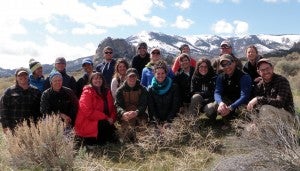
I recently developed IdahoWatch, a new STEM Service-Learning model, where graduate and undergraduate students take K-12 teachers into the field to learn about local research. The teachers participated in citizen science by recording behavior of Piute ground squirrels, greater sage-grouse and pygmy rabbits, and measuring habitat quality and use of habitats by these native species. They collected data and samples in the field that they use in lessons plans to teach their students what, how ,and why researchers study in this local ecosystem.
CONFERENCES AND WORKSHOPS
- 2014 – Invited IGNITE Speaker, The Wildlife Society Conference: “The Herbivore’s Prescription: A Tale of Wildlife-Directed Bioprospecting”, Oct 2014.
- 2014 – Invited Seminar Speaker, Department of Ecology and Evolutionary Biology, University of Tennessee, Oct 2014.
- 2014 – Invited Seminar Speaker, “The fate and consequences of eating toxic plants: pharmacological lessons from the wild side”, Dept. of Biomedical and Pharmaceutical Sciences, Idaho State University, Sept 2014.
- 2014 – Invited Symposium Speaker for Evolutionary Ecology Symposium: “Molecular mechanisms and ecological consequences of plant chemical defenses in vertebrate herbivores”, International Society for Chemical Ecology Meeting, University of Illinois at Urbana-Champaign, July 8-12, 2014.
- 2014 – Speaker: 29th Sage & Columbian Sharp-tailed Grouse Workshop: “Detecting palatable plants for sage-grouse in the sagebrush sea”. Elko, NV, 17-19 Jun 2014.
- 2014 – Invited Seminar Speaker, Department of Evolution and Ecology, University of California – Davis, Jan 2014.
- 2013 – Invited Symposium Speaker: Owyhee Research and Restoration Roundup. “Sage-grouse’s eye view of habitat quality” Marsing, ID, 23 Oct, 2013.
- 2013 – Invited Symposium Speaker: AAAS Symposium – Mechanisms of Tumor Progression & Cancer Therapeutics. “A co-evolutionary strategy to discovery novel anticancer drugs”, Las Vegas, USA, 18 June 2013.
- 2013 – Invited Symposium Speaker: Plant Herbivore Interactions Gordon Conference. “Scaling up dose-response curves: Translation between lab and landscape”, Ventura, USA, 24-28 February 2013.
- 2013 – Invited Conference Speaker for Great Basin Consortium Conference 2013: “A hungry sage-grouse’s view on habitats and climate”
- 2012 – Speaker: International Grouse Symposium 2012: “Hungry grouse in a warming world”. Matsumoto, Japan, 20-24 July 2012.
- 2011 – Invited Seminar Speaker: Department of Biological Science, California State University Fullerton. “Nature’s Chemical Arms Race: The defensive strategies of plants and herbivores”
- 2010 – Invited Symposium Speaker: British Ecological Society Annual Symposium 2010: “The integrative role of plant secondary metabolites in ecological systems.” University of Sussex, UK, 12 – 14 April, 2010. Invited by Dr. Glenn Iason (Macaulay Institute, Aberdeen, UK). “The herbivore’s prescription: A pharmacological perspective on host plant use by herbivores”
- 2009 – Conference Organizer: Society for Integrative and Comparative Physiology Symposium host: “PharmEcology: Integrating Ecological Systems and Pharmacology”, Jan 3-7, 2009; Symposium Schedule – SICB. Supported by NSF0827239, JS Forbey, PI
- 2008 – Invited Seminar Speaker: Department of Natural Resource Sciences, Washington State University and Department of Fish & Wildlife Resources, University of Idaho, “Behavioral, physiological and biochemical offenses of mammalian herbivores against plant chemical defenses”
- 2008 – Presentation: Pediatric Academic Societies’ Annual Meeting in Honolulu, Hawaii, May 3-6, Hawaii Convention Center, “Morphine analgesia and developmental kinetics in 3 to 18 year old children”
- 2008 – Presentation: 5th Annual Pediatric Research Conference, University of Utah, Salt Lake City, UT, “Morphine analgesia and developmental kinetics in 3 to 18 year old children”
- 2008 – Invited Poster: Regional Center for Excellence National Meeting for Biodefense and Emerging Infectious Diseases Research, Chicago, IL “The Translational Critical Path Initiative (TCPI) Catalyzes Discoveries into Products”
- 2007 – Invited Workshop Participant: Working Group 29: Herbivory; ARC/NZ Vegetation Function Network; Workshop at The University of Sydney
- 2007 – Invited Speaker: Department of Biology, Boise State University, “Ecology Meets Pharmacology: Mechanisms and Consequences of Toxin Exposure in Mammalian Herbivores”
- 2007 – Invited Speaker: Annual Rocky Mountain Regional Center for Excellence for Biodefense and Emerging Infectious Diseases Research, Fort Collins, CO. “From Ideas to Products: How the Translational Development Subcommittee, Intellectual Property Subcommittee and Cores Work For You”
- 2006 – Invited Lecture: University of Utah, “Preclinical Research in Drug Discovery and Development”, Salt Lake City, UT
- 2005 – Invited Symposium Speaker: International Mammalogical Congress, Symposium for Defensive Strategies Against Plant Secondary Metabolites in Mammals, “Overlapping lessons from human-drug interactions and plant-herbivore interactions”, Sapporo, Japan
- 2005 – Invited Speaker: NPS Pharmaceuticals, “Pharmacological foundations in ecology: the complementary nature of human-drug interactions and plant-herbivore interactions”, Salt Lake City, UT
- 2005 – Invited Speaker: Department of Biological Science, California State University, “Toxin tolerance in mammalian herbivores: mechanisms, constraints and implications for human benefit”, Fullerton, CA
- 2005 – Invited Speaker: Department of Biological Science, University of Montana, “Trade-offs of dietary specialization in a mammalian herbivore”, Missoula, MT
- 2004 – Invited Symposium Speaker: Plant-Animal Interactions Gordon Research Conference, “The importance of regulated absorption of plant secondary metabolites by herbivores”, Ventura Beach, CA
- 2004 – Invited Speaker: AgResearch Invermay & University of Otago, “The role of regulated absorption of toxins in herbivores and the biocontrol of brushtail possums”, Dunedin, New Zealand
- 2004 – Invited Speaker: Third International Conference of Comparative Physiology & Biochemistry in Africa: Animals and Environments, “Mammalian herbivores modify foraging patterns to regulate exposure to plant secondary metabolites”, Ithala Game Reserve, KwaZulu-Natal, South Africa
- 2004 – Invited Speaker: James Cook University, School of Tropical Biology, “No free toxic lunch- tradeoffs of dietary specialization in mammalian herbivores”, Cairns, Queensland, Australia
